
A Primmer on Guns for Story Writers
By
J.J.
Having read several action/adventure et al stories by new and struggling authors, I have come to the conclusion that some authors are getting their firearms knowledge from Hollywood. For this reason I have decided to write this primmer on the what for and how of guns in the real world.
It is not my intention to make you a firearms, or ballistics, expert. It is my intention to absolve some of the myths created by the cinema and give you an idea how the shooter will be thinking when it's time to get out the guns and start blazing away.
Note: When I use the term my shooting buddy I am referring to one of several acquaintances. I am just combining them all together into one person for sake of anonymity and ease.
I will break this out into three parts;
Pistols a.k.a. Handguns
Rifles
And
Shotguns a.k.a. Scatterguns
Pistols
Not always small enough to fit in your pocket
Most pistols will have an effective range of up to (but not completely limited to) twenty five yards. Beyond that range you are better off using a rifle. The pistol is a good quick and close defense weapon as well as being portable for taking into close offensive situations. It will not however give you pinpoint accuracy when fired quickly or beyond a range of fifty feet.
While having a higher velocity and being more accurate when you have time to steady and aim, the magnum pistol will give your hero a basic advantage only in terms of its penetration during a firefight. (In a shootout you aren't going to get the time needed to aim carefully.)
With a .357 or .44 Magnum your hero can shoot through the solid object the
opponent is using for cover. If the opponent is wearing a bullet proof vest a
.38 special will hit him and it is going to hurt him a bit, but that is about
all. If he is hit with a .45 ACP (Automatic Colt Pistol) the opponent will be knocked off of his feet. A
.44 Magnum hitting a vest will probably break a rib or two and do some internal
damage as well. And if the vest wearer is hit by a .50 Action Express he may
even be killed from the overwhelming transfer of energy that occurs when the
vest stops the bullet. This is why some body armor comes with shock plates, to
take up some of the energy transferred from the bullets when they hit.
Handguns come in two basic varieties, Revolvers and Autoloaders.

Three Revolvers;
A Charter Arms .44 Special
A Ruger Security Six .357 Magnum (Nickel)
A Ruger Blackhawk .357 Magnum
Revolvers
The Revolver has a rotating cylinder which holds a number of cartridges (usually 5 or 6) that come into line with the barrel for firing. The hammer will operate in one of two ways. Single Action, or Double Action
Single Action;
This requires the shooter to pull the hammer back into its full cocked position, using the thumb is normal, before the trigger may be pulled thus firing the weapon.
Note: Most single action revolvers have a Six shot cylinder. (Six Shooters) However, many people will load only five and leave the hammer to rest on an empty chamber. This is a safety precaution and not everyone does it, I do simply because I believe that if you cannot accomplish the job in five, you probably won't in six either. A cowboy in a western will always rest the hammer on an empty chamber. The empty chamber often held the cowboys emergency money.
Single action revolvers usually have a loading gate that allows access to one chamber at a time, so reloading is a very slow process. Knock out one empty shell, replace it with one cartridge, repeat as needed.
Double Action;
This allows a strong pull on the trigger to pull the hammer back into the full cocked position thus allowing faster repeated shots, but this does reduce accuracy as the long strong pull on the trigger will often cause the aim to waiver slightly. Most double action revolvers have a swing out cylinder that allows you to empty all of the chambers at once and if you have a small device called a speed loader, you can insert a full load into the chambers at once as well.
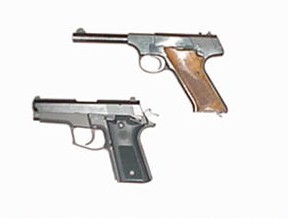
Two Autoloaders;
A Colt Huntsman (Woodsman Series) .22
A Daewoo DP-51 9 mm
Autoloaders
The autoloader has a removable magazine which resides (normally) in the handle and feeds the rounds into the chamber by way of a slide moving backward to release the spent cartridge and then sliding forward taking the next fresh cartridge into the chamber for firing. The trigger may then be depressed again to fire that round.
Semi Automatic
The types of fire for autoloaders is Fully Automatic, and Semi Automatic. Fully Automatic will fire when you press the trigger and continue firing until you release the trigger. Semi Automatic will fire once for each time you press the trigger, you must then release the trigger to depress it again and fire again. Fully Automatic are Illegal for sale in the United States and can only be purchased on the black market, or issued to the military. When you hear the term Automatic it is more than likely referring to Semi Automatic.
The Combat Pistol
Some autoloaders have a feature in which the empty magazine will push the slide lock into position locking the slide open when the pistol is empty. This is known as a Combat Pistol. No it has nothing to do with assault weapons (something I'll cover later) or any change in the rate of fire.
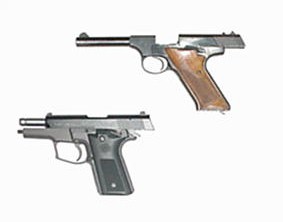
Locked Open
Bang bang, you're dead. Hey I said you're dead
In the Philippines, right around the turn of the century, the U.S. army was in a campaign against the Moros. The problem was, the enemy were so fanatical that when shot with the army's trusty .38 Special, even two and three times, they just didn't stop. It's so depressing to get speared by a fellow that you have shot full of holes and he just doesn't get it. So a heavy .45 caliber bullet with a low velocity and a left handed twist was developed. The .45 ACP is designed for low penetration and high knockdown. A person hit just about anywhere by a .45 ACP will go down. There is also a high likelihood of survival. Again, the special effects people in Hollywood aside, this bullet does not penetrate deep, unlike what you see in the movies, a .45 to the head most likely will not come out the other side.
There is a record of a police officer in New York who was met at the door by a bad guy with a .45. He grabbed the gun hand and the .45 went off in his face. The bullet went up his nose and literally followed the arc in his sinus cavity and came to rest in his sinuses. The police officer survived. (I think he had a headache though.)
Note: this may actually be an urban legend, however had the pistol involved been anything other than a .45 ACP, it would have never survived even as an urban legend.
Power
What are the most powerful pistols? The first one that comes to mind is the Desert Eagle .50 Action Express. This is followed by the .44 Auto Mag. (The Auto-Mag uses a wildcat round. That means you have to custom produce your ammunition.) However, there are now revolvers that chamber the .45-70 rifle round as well. This is a .458 caliber 400 grain slug traveling between 1700 and 1800 fps. That's 2568 foot pounds of energy, as compared to Dirty Harry's .44 Magnum which is a .429 caliber 240 grain slug traveling between 1300 and 1500 fps producing 1044 foot pounds of energy. If your wrist isn't broken, you may even fire a second shot.
Silencers.If your hero is using a revolver or a magnum, don't bother using a silencer. It's a waste of time. You see Hollywood only shoots blanks, so they can get silencers to work with these pistols. Your hero (or villain) is shooting real bullets and so will have difficulty getting the same results as Hollywood.
Problem 1;
Revolvers have a gap (the Barrel-Cylinder Gap) between the Cylinder and the Barrel. When a bullet is headed down the barrel of the revolver, gasses will escape from between this gap causing a small amount of flash and a considerable pop. So your silencer has just been rendered useless. You aren't going to get that nice Phpppt sound you hear in the movies.Problem 2
; Magnum pistols have rounds that travel at velocities up to eighteen hundred feet per second. That's twelve hundred miles per hour. Considering that the speed of sound is seven hundred and fifty miles per hour, that makes the bullet supersonic. So immediately after the Phpppt of your silenced pistol comes the Sonic Boom of the bullet traveling toward its target, once again rendering your silencer useless. If you happen to be indoors, like in a warehouse or parking garage, the echo of the sonic boom will be deafening as well.If you are going to silence you must always stay with a sub sonic round;
.45 ACP (Automatic Colt Pistol)
9 mm parabellum
.380
.22 short
The best pistols to silence are the;
M1911 .45 military
Walthler P-38
Parabellum P0-8
Ruger MK II .22
This is by no means an exhaustive group, but it's a good basic group to use.
Each of these autoloaders has the distinction of a chamber pressure of zero when the breach opens along with a sub-sonic bullet thus allowing a truly silenced shot. Of course you may want to remain aware of the fact that the slap of the bullet against a person's body will actually be louder than the silenced shot.
Note: The Walthler PPK (Favorite of James Bond) has a slight pressure in the chamber when it opens making its silenced version sound like an extra loud child's cap gun going off.
Here's a quickie
The Ruger MK II .22 can be quickly silenced by using an empty Coka Cola bottle (the plastic kind) for a short range shot. While deadening the sound almost totally, make note that beyond fifteen feet range the deflection caused by the plastic bottle may be enough to miss a human target. So NO pinpoint accuracy if this is used. Mob hit men have used this very technique in real life when removing undesirables. (Something else of note; the Ruger MK II is the most popular pistol used by underworld assassins currently.) Also be sure to remember that this is done with a .22 short in the chamber, not a .22 long, as always the rule is; sub-sonic.
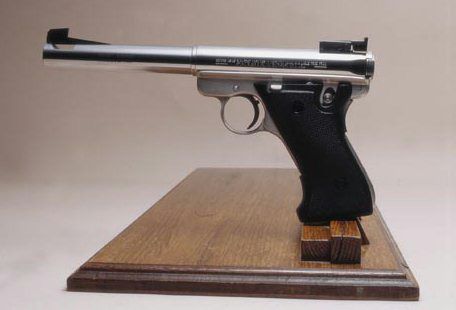
The Ruger MK II
Rifles
Rifles will have effective ranges from fifty feet out to over one thousand yards depending on caliber and load. You have the bolt action single shot rifles which are very accurate and the fully automatic squirt guns which will make lots of noise, but aren't very accurate, there is the dreaded Assault Rifle (Shudders and ooooohs from the audience) and the good old cowboy lever action. Each has a use and a place.
The bolt action rifle is the most accurate rifle for the situation where one shot will get the job done. A bolt action with a scope is going to allow accurate shots for almost anyone out to five hundred yards. Chambering a round in a bolt action requires lifting the bolt lever and drawing the bolt back manually then sliding the bolt forward and locking it in place once again. When you need to fire quickly this is not the best way to go about it.
The Assault Rifle is generally a select fire rifle that is chambered in 7.62 mm Nato and fires what is known as Military Rounds. (It's basically a .308 with a full metal jacket.) I know, I know, the AR-15 and all of its spin-offs chambers a 5.56 NATO as well. I still think there are more of the 7.62 out there. I could be wrong.
Anyway, remember that federal law prohibits the sale of fully automatic rifles to the general population so a civilian "assault rifle" cannot select fire, it is limited to semi automatic fire only. It just looks meaner than a sporting rifle. Also note that a full metal jacket bullet is a bullet that will have a tendency to remain intact even after contact with a target. It doesn't mushroom as easily as a sporting round. So depending on where a person is hit, there is a greater likelihood of injury over death. In a combat situation injury is preferable to death.
A dead soldier removes one from the battlefield, a wounded soldier removes three.The assault rifle on fully automatic fire is also notoriously poor for accuracy. However, the purpose for fully automatic fire is NOT, as Hollywood would have you believe, for the purpose of mass murder. Fully automatic fire is intended to serve the purpose of suppression fire. In other words, make the other guy duck and cover.
"I can't get no lower Joe, the ground's in the way." During this time those soldiers with the single shot rifles can then effectively shoot and wound the enemy soldiers while they are hiding and not shooting back. (Well that's the theory anyway.) Statistically it takes three thousand rounds of ammunition to create one causality on the battle field. "I'm not worried about the bullet with my name on it, it's all those others marked to occupant that bother me."Fully automatic weapons which I like to call squirt guns generally have large capacity magazines, often referred to as sticks, and fire rounds rapidly as you depress the trigger. They are more useful in cover fire situations than when accuracy is called for. It's the spaghetti theory of shooting,
if you send enough bullets out there, one of them is bound to hit something. They also run out of ammunition very quickly. While Arnold Schwartzenhager can fire a Mac 10 all day, a 32 round magazine in the .45 caliber version of a Mac 10 with a cyclic rate of fire at 10 rounds per second (RPS) empties in roughly 3.2 seconds, 1.5 seconds in the 9 mm version's 22 RPS cyclic rate of fire. The effective range is roughly 50 feet for squirt guns if used for anything other than cover fire. My own personal opinion is that squirt guns are useless for anything other than an ego trip for the shooter.The Killer in D.C.
A lot of confusion and misinformation was bandied about when the D.C. Sniper was on his rampage. We heard tell of how he had to be some specially trained and prepared individual in order to do what he had done.Bull#%&@!
Kahzeuntite!
This person was not selecting a victim and then dealing with the conditions. He was selecting the conditions and then dealing with the victim. In other words, he was taking easy shots. You can do that with iron sights (no scope) out to 200 yards and still be successful. So if you have a random killer in your story, any jerk can fill the bill. But if your hero or villain is doing special shooting, they are going to have to know how.
The Gravity of the Situation
Picture this. You have a rifle, with the barrel exactly parallel to the ground. You are holding a bullet next to the barrel. If you could release that bullet at the exact instant that someone shoots the rifle, both bullets will hit the ground at the very same time. This is the primary factor in trajectory.
A bullet will never travel a straight line. It moves from the instant it leaves the barrel. And for this reason any competent shooter knows that they are going to have to correct for this movement. So when your hero sets up for his shot, he will sight in his rifle for a specific range and from that point on he will not fiddle with his rifle or the scope in any way shape or form.
He will NOT disassemble the rifle!
He will NOT take the scope off of the rifle!
He will NOT make any adjustments to the scope before shooting!
What he will do is to put the rifle in its case and pray nothing causes the settings to move during transport.
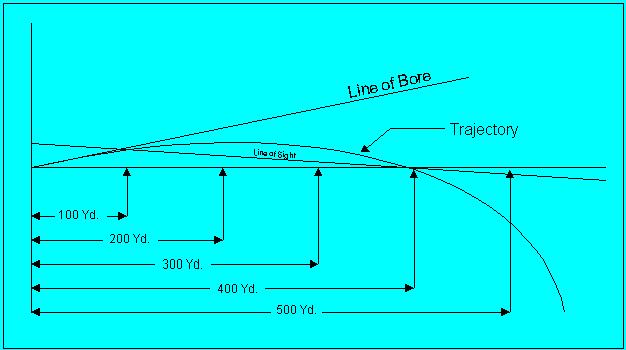
A look at Trajectory
Depending on the load used, the velocity and drop of a bullet in flight will vary. For purposes of this discussion I have chosen a .308 Winchester (7.62mm NATO) 150 grain Spitzer (by Speer) on a load of 43.0 grains of H335 powder. This produces a muzzle velocity of 2600 Feet Per Second. The bullet has a sectional density of .225 and a Ballistic Co-efficient of .389. From that I developed the following trajectory chart.
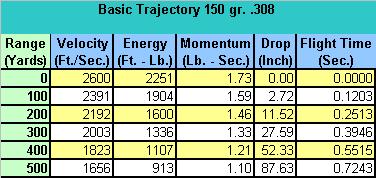
Basic Trajectory Chart
The Basic Trajectory Chart shows the deceleration of the bullet out to 500 yards, the energy loss due to wind resistance, the time of travel, and the amount of drop the bullet will experience. To compensate for this situation the shooter will sight his rifle at specific distances and then create a compensation chart for alternative distances. The longer the shot you expect to take, the farther you will sight the rifle. For competitions my shooting buddy will sight his rifle at 600 yards, while I sight mine at 400 yards.

Bullet Path Chart
The above chart shows the differing compensations necessary when a rifle is sighted at differing ranges. For example, if you were sighted in at 300 yards and were taking a shot at 500 yards the bullet will strike 24.4 inches below where your crosshairs center. So the shooter will have to pick a point 24.4 inches above the target to hit the target in the center. If on the other hand you were taking a shot at 100 yards the bullet will strike 16.4 inches above where the crosshairs are centered. So the shooter will have to pick a spot 16.4 inches below the target to hit it center.
NOTE:
At NO time will the shooter adjust his scope and crosshairs to compensate for this trajectory. There is no way for him to know what adjustment to make. He will make his corrections by where he places the crosshairs. Hollywood, for some reason, always places the crosshairs square on the target regardless of range or any other factors. In our example above the shooter will only do so when shooting at a target 300 yards away.It's no breeze
After Gravity there is also something called wind. That's right, your hero isn't going to have perfect conditions every time. Sometimes there is more to compensate for than range.
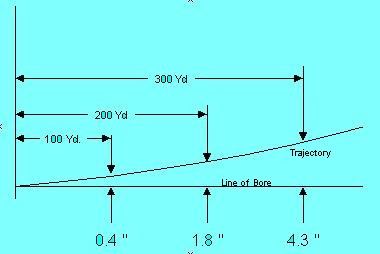
Wind Deflection Path
5 MPH Wind at 90 Degrees to the bullet path.
There is an old term Kentucky Windage which refers to the practice of aiming to the left or to the right to compensate for wind. The bullet travels through the air, and is therefor subject to the forces that the air has to offer with regards to its flight. Again a chart can be created for the effects of wind so the shooter may know the necessary compensation in order to hit center target.
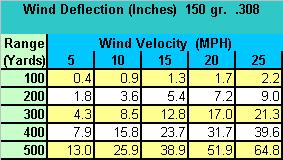
Wind Deflection Chart
Assumes 90 degrees to the bullet path
So now let's assume our shooter is shooting at a target 500 yards away in a 10 M.P.H. wind blowing left. The shooter must then pick a spot 24.4 inches above and 25.9 inches to the right of the target in order to hit center. This is why most long range shooters will have a spotter. A spotter will use a high powered viewing scope and tell the shooter where he has placed his shot. In the case of our 500 yard shot he may inform the shooter he was down by 10 inches and left by 15 inches. The shooter will then correct his compensation by those amounts selecting a point 34.4 above and 40.9 inches left of the target to Fire For Effect (FFE).
There are a myriad of other factors involved as well. Shooting from a higher elevation, or from a lower elevation will change the gravitational arc. Is the target moving, and how fast, hence the time of flight factors included in the basic trajectory chart. If a rifle is sighted in on a cool day, say 56 Deg. F and the shot taken on a hot day, say 92 Deg. F the ground convections may cause the bullet to float, thus striking 2 to 4 inches high at 500 yards. My shooting buddy uses an open hand on his stock, while I use a sling when shooting. The downward pressure generated by wrapping my arm in the sling will cause the bullet to strike 6 inches lower at 300 yards. So your hero cannot just pick up a strange rifle and exercise pinpoint accuracy at 500 yards. Unless your hero is going to have a couple of hours at the range, shooting several 5 shot groups, the best option available is to test fire a couple of rounds at 100 or 200 yards and see where the rifle is hitting, then compensate when the shot is taken. Again, he will NOT adjust anything on the rifle.
I don't see how you can compensate?
Hollywood likes those red dot reticles. I personally do not. While there are several good reticles available commercially, a proficient shooter will most likely get a custom reticle for taking that all important shot. The custom reticle will not be readily available over the counter. Your hero, or villain, will most likely have to order it special.
Common Reticles
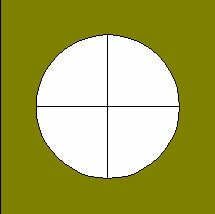
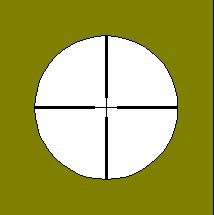
Crosshair Reticle
Duplex Reticle


Post Reticle
Dot Reticle
A custom Reticle
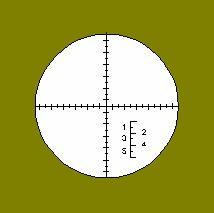
The Doohickey in the lower right is a range finder.
By selecting an object of known size, one can measure it in the range finder and
then check on a chart to determine what the range to the target is.
If you will note, the custom reticle has ladders on the crosshairs. These are used to determine the elevation and windage compensations for the shot. Dependant on magnification and range the ladders will represent differing scales in order to correct the sight picture for the shot.
Putting it all together
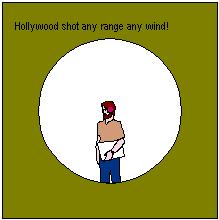
Here we see the Hollywood Site Picture; please note that any fool can
do this.
But real shooting requires training for a reason
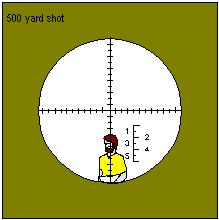
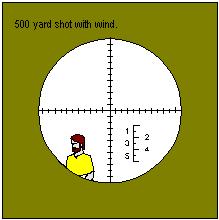
The above two Images show what the shooter is going to have to
look at in order
to hit the target at a range longer than the zero range set for his
rifle, or with wind as well.
Please Note: that they do not look at all like what Hollywood would have you
believe.
So, what is good shooting?

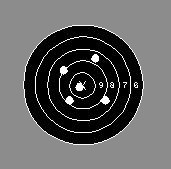
Target
A
Target B
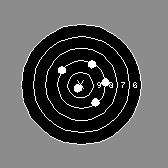
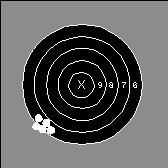
Target
C
Target D
Quick Poll:
Select the target above that you believe represents the best shooting.Poll Results
Target C 47%
Target B 42%
Target D 7%
Target A 4%Note: this article was originally published in an interactive forum.
Okay, what should my Hero shoot?
In spite of what Dan Rather has told you on the CBS Evening News, the .30-06 (pronounced thirty ought six) is not a
special high powered rifle. Outside of the .22 which is almost ubiquitous for rifle chambers, the .30-06, the .308 (a.k.a. 7.62mm NATO), and the .30-30 are probably the most common chambers for civilian rifles. While being very common, and all having good trajectory characteristics, beyond 500 yards a Magnum will be a more likely rifle for the job.For a special high powered rifle try a wildcat round, like a .375 H&H Magnum necked down to .30 caliber. If, on the other hand, you want an over the counter high powered round, you will invariably get an argument if you ask more than one expert at the same time. My shooting buddies each have their favorite; the.460 Weatherby Magnum, the .300 Winchester Magnum, or the .300 H&H Magnum. (There are more, I just don't have room to go into this.) My personal favorite is the 7mm Remington Magnum. Any of these will be good to 1000 yards.
Of course a custom rifle chambered to take the Browning .50 caliber represents the extreme. That dream rifle-- the Holy grail if you will. The Browning .50 will penetrate any armored limousine there is, it can even disable the tracks on an M-1 Abrams tank (It's not easy, but it can be done) and it is very accurate out to 1800 yards. The downside is the rifle is very large and very heavy. The barrel is so heavy that it will likely require a bipod in order to shoot it. So your hero, or villain, won't be hiking into the mountains with one of these rifles any time soon.
Where did that shot come from?
Because of the echo and the sonic boom of the projectile, there is little chance that anyone will be able to tell where a single shot comes from. With each additional shot, the likelihood of locating the source of the shots goes up. So of course Hollywood solves this by putting a silencer on the rifle. Please, don't even think about doing this in your stories. You see Hollywood saw something that looked like a silencer so they added that to their repertoire. What they saw, however, is not a silencer. It is what is known as a Muzzle Break.
If it doesn't make it quiet, what does it do?
When I shoot my 7mm Remington Magnum, I use a 145 grain Boat Tail .284 dia bullet in front of 60.0 grain of 4350 powder. This produces a velocity of 3075 fps. (The boat tail bullet has a Ballistic Coefficient of .465. That means it keeps its velocity and energy longer.) This creates a muzzle energy of 3093 foot-pounds. Sir Isac Newton explained to us that for every action, there is an equal and opposite reaction. The real action coming out of the end of my rifle barrel however, is 4373 foot pounds of energy, this is because for purposes of recoil, the powder is also included in the mass. So my shoulder is taking up the equal and opposite reaction of the bullet and the powder leaving the end of my barrel.
Basically what this amounts to is my shoulder is taking on a total of 19.1 foot pounds of energy traveling at 12.4 fps when I fire the 7mm Rem. Mag. Compare this with a .30-30 Winchester 10.6 foot pounds at 9.5 fps, a.308 13.2 foot pounds at 10.7 fps or the .30-06 17.6 foot pounds at 11.9 fps. In simple terms, imagine someone hitting the end of my barrel with a 19 pound sledge hammer, slamming the rifle butt into my shoulder with that force, and that's what we're talking about.
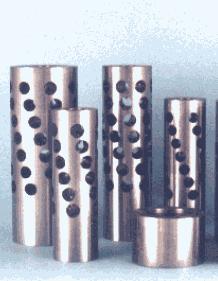
Muzzle Breaks
Enter the muzzle break. In its simplest form it is a short barrel extension that filled with holes to allow the gases to escape in all directions perpendicular to the barrel, thus reducing the recoil my shoulder absorbs by up to 30%. If you've ever fired a Magnum rifle, that 30% is a LOT!. There are some muzzle breaks that have gas reversers. They cause the gas to escape at 30 degrees rearward. They can therefor reduce the recoil by as much as 50%. While they do not reduce the noise any, they do make it easier to shoot without flinching before the shot. This increases accuracy.
Flinching, is a term that describes getting ready for the recoil. When shooting properly, you squeeze the trigger, adding pressure until the rifle fires. If done properly you should actually be surprised by the rifle going off. It is natural, however, to get a little prepared when you've had your shoulder slammed enough times. By reducing the recoil, you're less likely to get prepared, that's the purpose of the Muzzle Break.
Well then, how do I keep my Villain from getting caught?
Once again, while the yoyo in Maryland was out there killing people for real, we heard lots of discussion about things like Ballistic Fingerprinting. I won't go into the technical details why this is nothing more than a Twinkie (Looks good, tastes good, makes you feel good, but there is no nutritional value.) I will let you in on something that makes it all moot.

Discarding Sabot
The above image is of what is known as a .223 Discarding Sabot. The funny plastic flange around the bullets are a shoe that carries the .223 bullet down a .30 caliber barrel. When the unit clears the muzzle, the plastic will strip off, due to heat and speed, leaving a clean (that is no engraving) .223 bullet speeding toward it's target. (At hyper velocities I might add.) There is no way to match that bullet to the rifle that fired it. So much for ballistic fingerprinting.
Answers to the Pop-Quiz Aboveà
Target D is the very best,
followed by Target A,
Target B is the very worst.
What any shooter is looking for on a target is not the bullseye, it's the grouping of his shots. This denotes consistency. Through adjustments to the sights, or scope, the group can then be moved to the center of the target.
Shotguns
When close counts.
There are people in this world who will jump you while you hold a .38 special in their face. These same people will suddenly decide they have something more important to do elsewhere as soon as they hear the sound of a pump action shotgun cycling. At close range, and in defense of a home, there is probably no more devastating weapon than a shotgun.
There are three general types of shotguns. Break action, pump action and autoloader. A break action shotgun has a hinge which allows it to bend just in front of the small of the stock allowing you to place one or two shells (single or double barreled) and closes ready to shoot. The pump action has a sliding forestock which when pulled back opens the breach and loads another round when the stock is slid forward. The autoloader works just like the pump action, but it uses the recoil to cycle the action.
The diameter of the barrel is measured in what is called gauge. The most common gauge is 12, but there are some 10 gauge out there. (That's the biggest!) A gauge popular with women is a 20 gauge, approximately 1/2 the diameter of a 12 gauge. The smallest is 410 gauge. In an action story a 12 gauge will be most prevalent but you could get away with a 20 gauge.
Unlike pistols and rifles a shotgun does not shoot a single bullet. Instead they fire many little balls (like BB's) called shot. The size of the shot is measured by numbers, the smaller the number the larger the ball. Number 9 shot is approximately a 1/8 inch diameter ball. Number 4 is approximately 1/4 inch diameter. The largest shot is 00, called double ought. What will happen upon firing is the shot, which aren't guided by lands and grooves to stabilize the projectiles, will spread out creating a larger area of coverage. That means you can do a lot of damage without being able to aim so good.
In fact, the shorter the barrel on the shotgun the quicker the shot spreads out. This is where you get the sawed-off shotgun. A sawed off shotgun will be effective in situations where the range is not going to exceed thirty to forty feet, beyond that range you will still hit people, but you are more than likely to make them mad at that point. The shot becomes so spread out that it is no longer effective against humans. The optimum combination for a hero in your stories using a sawed-off shotgun is a 9 inch barrel using Number 4 shot, Note: this would be a break action shotgun.
Going the other way, a longer barrel will have a slower spread of the shot pattern. You can then add a device (or permanent modification to the barrel) called a choke. A choke ranges from Cylinder Bore to Modified, to Full Choke. The purpose is to allow for greater range when using a shotgun.
Suffice to say that Double Ought Buck (00 shot, called buckshot as it was originally used to hunt deer) is the glamour item in the movies. But there are so few pellets in a load, that it quickly becomes ineffective as you have lost the advantage of only having to be close. Double Ought requires you to be slightly more accurate in your shooting.
Another advantage of shotguns is their ability to use Rock Salt in place of shot pellets for nuisance intruders. It hurts like hell, but doesn't kill. For the poetic justice in you, you get to pour salt in the wound even as you make it.
Finally, if you can take the time to aim, you may want to use a rifled slug. This is a very big projectile with self stabilizing slots that allow the slug to spin for accuracy's sake. If you're facing a grizzly bear it is comforting to have a couple of rifled slugs in the magazine of your pump shotgun. Outside of that situation, there is no major advantage.
That's all?
As I said, this is a primmer, not an in depth study. It is my hope that what I have contained herein will be helpful in avoiding errors that are glaring in nature and give you a feel for how your villain (or hero) may be thinking before making that all important sniper shot. Feel free to send questions if you have any questions. I will either be able to answer your question, send you to someone who can, or throw up my hands and shrug.
A Glossary of terms
Remember: If you cannot
impress them with intelligence, baffle them with Bull#$%&
ACCURACY: The measure of precision in consistently obtaining a desired result. In shooting, the measure of a bullet's or gun's precision in grouping all shots close to the center of impact.
ACTION: The mechanism of a firearm by which it is loaded, locked, fired and unloaded.
AIR RESISTANCE: The resistance of air to the passage of a projectile in flight.
BALL: Early term for "bullet." Still used in military nomenclature.
BALLISTICS: The science of projectiles in motion. Divided into;
BALLISTIC COEFFICIENT: Basically a measure of how streamlined a bullet is; that is, how well it cuts through the air. Mathematically, it is the ratio of a bullet's sectional density to its coefficient of form. Ballistic Coefficient is essentially a measure of air drag. The higher the number the less drag, and the more efficiently the bullet cuts through the air.
BARREL-CYLINDER GAP: The opening or clearance between barrel and cylinder in a revolver.
BEARING SURFACE: That portion of a bullet's surface that touches the bore in moving through the barrel.
BEDDING: Manner in which the barrel and action of a rifle is fitted to the stock.
BENCH REST: A solid table or bench, used for supporting a gun when testing for accuracy. Bench Rest target shooting has become an important Shooting sport.
BLACK POWDER: A propellant for muzzle loaders and early cartridge arms, composed of a mixture of potassium nitrate (salt-peter), charcoal and sulfur.
BOAT TAIL: Name given to a bullet type with tapered base. Also "taper heel".
BODY: of a case: That section of a cartridge case between the head and the shoulder. The part of the case that contains the powder.
BOLT: The locking and cartridge head supporting mechanism of a firearm that operates in line with the axis of the bore. It contains the firing pin, firing pin spring, extractor(s) and sometimes the ejector.
BORE: The inside of the barrel of a gun of any kind and, in rifled arms, the diameter of the barrel before the rifling is cut.
BORE SIGHT: To align the sights of the firearm with a target by sighting through the bore.
BRASS: A term often applied to empty cartridge cases. An alloy of copper and zinc of which cartridge cases are usually made.
BULLET: The missile only. Becomes a projectile when in flight. Not to be applied to the "cartridge." See also "Ball."
BULLET PATH: The location of the projectile above (+) or below (-) the line-of- sight at a given range.
BURNING RATE: A relative term. The rapidity with which a given powder burns in comparison with other powders.
CALIBER: A term that derives from Latin qua libra, "what pound", first applied to the weight of a bullet and then to the diameter. Caliber now refers to the diameter of a projectile, or the diameter of the bore of a gun. It is the approximate bore or groove diameter expressed (in English) in decimals of an inch, otherwise in the metric system. Frequently compounded to indicate powder charge; to show date of adoption; to show case length; or to show proprietor or designer e.g. .30/40, .30 '06, 8 x 57mm, .375 Holland & Holland, or.257 Roberts.
Also used as a measure of length equal to the diameter (or caliber) of a specified gun, as; a "fifty caliber" barrel would be 50 bore diameters long. A "6 caliber" bullet ogive would have a radius of 6 bore diameters.
CARTRIDGE: A complete unit of ammunition assembled. i.e.: Case, propellant, powder, primer, and bullet. Usually applied only to rifle and pistol ammunition, but occasionally to shotshells.
CASE: The paper, metal, or plastic con tainer which holds all the other components of a round of ammunition. Sometimes called "hull" or "shell".
CASE FORMING: To form cases of one caliber into another caliber.
CENTER FIRE (CF): Refers to centrally located primer in base of metallic cartridges. Most center fire cartridges are reloadable.
CHAMBER: That part of the bore, at the breach, formed to accept and support the cartridge.
CHARGE: The amount of propellant powder measured into the case in loading. Also refers to amount of shot measured into shotshell.
CHOKE: A constriction at the muzzle of a shotgun barrel, designed to control or reduce the spreading and dispersion of the shot charge.
COMPONENTS: Those parts which go into the making of a cartridge.
CORROSION: The eating away of the bore because of rusting or the chemical action of salts deposited in the bore by the primer or powder.
DRAMS EQUIVALENT: Term used to indicate that a charge of smokeless powder produces the same velocity as a given number of drams charge of black powder. Thus, a 3 dram equivalent load has a charge of smokeless powder that gives the same velocity as a similar load charged with 3 drams of black powder.
DRIFT: In exterior ballistics the deviation of a projectile from the line of departure due to its rotation or spin.
DROP: The distance a projectile falls due to gravity, measured or calculated from the line of departure. Must be corrected for difference between line of sight and line of departure.
ELEVATION: The vertical adjustment of a sight to bring the point of aim into coincidence with the point of impact.
ENERGY: The amount of work capable of being done by a projectile at a given range, expressed in foot-pounds. Found by multiplying the square of the velocity in fps by the weight of the bullet in grains and dividing by 450,240.
ENGRAVING: The marks made on the bullet by the rifling.
EROSION: The wearing away of the bore of a firearm due to friction from the bullet or shot, or from hot powder gases.
FIREFORM: Shaping a cartridge case to fit a given chamber by firing the case in the chamber.
FIRING PIN: That part of a gun's mechanism that strikes the primer.
FOOT-POUND: A unit of kinetic energy equal to the effort required to raise one pound to a height of one foot against normal gravitational force.
FORM FACTOR: A multiplier which relates the shape of a bullet to the shape of the standard projectile used to prepare a particular ballistic table.
FMJ: Full metal jacket. See "Metal Case."
GAS: In handloading, the vapor form of burning powder. This heavy gas is capable of expanding rapidly, creating sufficient pressure to propel the bullet.
GILDING METAL: A copper-zinc alloy used for bullet jackets. Usually from 5% to 10% zinc, balance copper.
GRAIN: In weight measure 7000 grains equal one pound; 437.5 grains equal one ounce. May also be used in referring to a particle, or kernel, or powder. However, "35 grains of powder" always refers to 35 of the weight-unit grains, never to 35 individual kernels of powder.
GRANULATION: Refers to grain size and type. Can apply to black or smokeless powder.
GROOVES: Spiral cuts or impressions in the bore of a firearm which cause a bullet to spin as it moves through the barrel. See also LANDS
GROUP: The pattern made, at the target, of a number of shots fired with one aiming point and usually one sight setting. Usually measured from center to center of the holes farthest from each other.
GUN POWDER: Propellant explosive used in small arms. Can be either smokeless or black powder.
HALF JACKET: A short jacket, or bullet swaged with a short jacket, which leaves some lead in contact with the bore. A three-quarter jacket is similar, but longer, so the bearing surface of the bullet is covered by the jacket material.
HANDLOADING: The loading or reloading of small arms ammunition by hand powered methods.
HANGFIRE: Ignition in a cartridge which is delayed beyond the normal time after the firing pin has struck the primer.
HOLDOVER: The distance above target a shooter must "holdover" to hit at ranges greater than the gun's "zero." See "zero"
HOLLOW POINT (HP): Bullet design feature; an axial hole at point of bullet.
HYDROSTATIC SHOCK: A highly destructive shock wave created by a bullet passing through animal tissue, which is high in water content.
IGNITION: The setting on fire of the propellant powder charge by the primer.
IMPROVED: Term used to indicate a standard cartridge case which has been altered by fireforming to reduce body taper and/or increase shoulder angle. Improved cases have greater powder capacity than the corresponding standard case.
IMR: Abbreviation for "Improved Military Rifle." The name given by DuPont to its line of single base rifle powders.
INGALL'S TABLES: Ballistic tables computed by Col. James M. Ingalls and first published in 1918. The most widely used ballistic tables in the U.S.
JACKET: The cover or skin of a bullet; usually made of gilding metal in the U.S. Gilding metal-clad steel or mild steel are also used. See "Cupro-Nickel" and "Half- jacket. "
KEYHOLE: The imprint of a bullet on a target, which shows that the bullet was not traveling point-on at the time of impact.
LANDS: The spiral raised portion of a bore remaining after the grooves have been cut or formed.
LEADING: Lead deposited in the bore from shooting lead bullets. A form of metal fouling.
LINE OF DEPARTURE: That particular line at which a bullet leaves the muzzle of a firearm. The bullet immediately falls away from this imaginary line.
LINE OF SIGHT: The straight line through the sights of a gun to the point of aim.
LOCKING LUGS: Protrusions at the bolt which engage a mating recess inside the receiver ring when the bolt is closed. This feature prevents the bolt from moving rearward when the rifle is fired.
LOCK TIME: The period of time between the release of the sear by trigger movement and the instant the priming mixture detonates after being hit by the firing pin.
MAGNUM: A load, or cartridge having greater power. A magnum case is usually longer. For example, the .44 Magnum is approximately 1/8th inch longer than the .44 Special. Or it may be a caliber with exceptionally large powder capacity in relation to the bore diameter; for example, the .264 Winchester Magnum.
MEAN RADIUS: The average radius of a group of shots from the center of the group.
METAL CASE (MC): Also Full Patched (FP) or Full Metal Jacketed (FMJ). A type of bullet in which the core is completely encased in jacket material, except for a small opening on the base. Standard military bullet type.
METAL FOULING: Bullet jacket material deposited in bore. Not common since adoption of gilding metal for jackets.
MID-RANGE TRAJECTORY: Usually refers to the highest vertical distance of a bullet above the line of sight at a point approximately half way from muzzle to target or point of aim. Sometimes abbreviated as 'MRT."
MINUTE-OF-ANGLE: A unit of angular measurement equal to 1/60th of a degree. Although usually approximated as one inch to the 100 yards, it is actually equal to 1.047' per 100 yards. Sometimes abbreviated as "MOA."
MISFIRE: Complete failure of a cartridge to fire after the primer is struck by the firing pin.
MUSHROOM: The ability or capacity of a bullet to expand on or after impact. The name comes from the desired shape after expansion.
MUZZLE: The front end of a barrel. The point at which a projectile leaves the barrel.
MUZZLE BLAST: The blast of the hot powder gases from the muzzle of the gun with the attendant flash and noise.
MUZZLE ENERGY (ME): The energy of a bullet at the muzzle. See "Energy."
MUZZLE PRESSURE: Gas pressure in the barrel at the muzzle at the instant the bullet leaves the muzzle.
MUZZLE VELOCITY (MV): See "Velocity.
NECK: That portion of a cartridge case which grips the bullet. In a bottlenecked case, that portion of the case in front of the shoulder.
NECK DOWN OR UP: To reduce or increase the diameter of the neck.
NECK EXPANSION: The act of expanding a sized case neck by pulling it over an expander plug or button.
NECK SIZE: To resize part or all of the neck only.
NON-CORROSIVE: Cartridges or primers with priming mixture that does not contain any compound apt to cause rusting or corrosion of bore or adjacent parts. With such priming mixtures, it is not mandatory to clean the bore immediately after firing. All commercial small arms ammunition primers made in the U.S. and most military ammunition produced since 1952 has non-corrosive primers although it is well to clean the bore promptly when in doubt.
NON-MERCURIC: A priming mixture containing no mercury or its various compounds.
PARALLAX: The condition that exists when the reticle of a scope does not lie exactly on the image plane.
PARTITION: A bullet design using a solid partition in the jacket to improve retained weight after bullet impact.
PATCHED OR PAPER PATCHED BULLET: A bullet, commonly used in older black powder cartridges, with a wrapped paper "patch." Derived from the even older "patch" used to wrap a muzzle-loader ball. The "patch" helped seat the powder gases and reduced bore leading.
PATTERN: The way a shotgun places its shot load. Generally measured as the percentage of a full shot charge that is placed in a 30' circle at 40 yards.
PLINKING: Shooting for fun without formal target-shooting rules.
POINT OF AIM: That point on which a gun's sights are aligned.
POWDER: The propellant material used in most firearms. Divided into two basic types: "Smokeless" powder and "Black powder" or "Gunpowder." It is produced in a wide variety of types, forms and brand-names intended for specific applications. It varies chiefly according to burning speed. The fast-burning types are used for light bullets in short barrels at low velocities: slower-burning powders are used in longer barrels and in greater quantities to drive the bullet at higher velocities. Most powder contains a major percentage of nitrocellulose, with small traces of other compounds intended to control burning rate or prevent deterioration; such powder is called "Single-Base"; smokeless powders containing a percentage of nitroglycerine are called "Double-Base"; and powders containing substantial amounts of other organic nitrates are called "Multi-Base." Further identified by shape of individual kernel or granule, i.e. tubular, flake or ball. See "Ball Powder."
Black powder is a mechanical mixture of sulfur, charcoal, and saltpeter. It is now used primarily in muzzle-loading guns.
PRESSURE: The pressure exerted by a burning charge of powder in the chamber of a gun. Expressed normally as the peak pressure in pounds per square inch (psi).
PRESSURE-VELOCITY RATIO: Ratio of velocity to pressure in a specific cartridge with given bullet and given powder.
PRIMER: Also called "cap", deriving from "percussion cap" which is the priming form used with some muzzle loading arms. in a centerfire cartridge, the small metal cup containing a detonating mixture which is used to ignite the propellant powder. The primer is seated in the primer pocket in the base of the cartridge case. The standard American type of primer, the "Boxer," also contains an anvil. Electrically fired primers are used in some military weapons and in some experimental European sporting arms. In a rimfire cartridge the priming mixture is contained within the rim of the case. See "Anvil," "Berdan," "Battery Cup."
PROJECTILE: A bullet, or any other object, projected by force and continuing in motion by its own inertia. NOTE: A bullet is not a projectile until it is in motion.
PROPELLANT: See "Powder".
RANGE:
1. A place where shooting is conducted.
2. The horizontal distance of travel of a projectile.
RECOIL: The backward thrust or "kick" of a gun caused by the reaction to the powder gases pushing the bullet through the bore, and the jet effect of the gases themselves.
RECOIL BUFFER: A spring loaded device to help control recoil, most usually used on Colt .45 Auto Pistols.
RELOADING PRESS: A tool used in reloading ammunition. Usually has some form of mechanical advantage to reduce effort in resizing or reforming cases. Available in several basic types known by the shape of letters of the alphabet; "C", "H", and "O" types are most common.
REMAINING ENERGY: The residual energy of a projectile, measured in foot pounds, at a given distance from the muzzle.
REMAINING VELOCITY: The speed of a projectile at a given point on its trajectory.
RETICLE: The aiming indicator at the focus of a telescopic sight. May consist of straight or tapered lines, dots, or other marks used to determine the point-of-aim, size of, or range to, the target.
RIFLING: Parallel spiral grooves cut or impressed into the bore of rifles and pistols in order to make the bullets spin, insuring steady, point on, flight to the target. See "Grooves" and "Lands."
RIM: The projecting edge at the base of most cartridge cases upon which the extractor pulls. In England this is called the "Flange."
RIMFIRE (RF): Cartridges which contain the priming mixture within the rim. This type is not reloadable under practical conditions.
ROUND: A military term meaning one complete cartridge.
ROUND NOSE: Bullet design feature, Blunt, spherical, nose shape.
RUPTURE: Also "Separation." A failure or break in the wall of a cartridge case.
SAAMI: The Small Arms and Ammunition Manufacturers Institute. The organization which standardizes case and chamber specifications in the United States.
SABOT: In modern small arms usage a lightweight carrier or "shoe" in which a subcaliber projectile is centered to permit firing the bullet in a larger caliber barrel.
SEATING DEPTH: In a loaded round, the depth to which the base of the bullet is seated below the case mouth.
SECTIONAL DENSITY: A bullet's weight, in pounds, divided by the square of its diameter, in inches.
SHANK: The cylindrical section of a bullet below the ogive.
SHOCK: The effect of the transference of a bullet's kinetic energy to animal tissue or other target.
SHOCK WAVE: The compressional wave formed whenever the speed of a projectile relative to air or other medium exceeds that at which the medium can transmit sound. Also "Blast."
SHOT: The lead alloy spheres, sometimes copper or nickel-plated, which are used for the projectiles in smooth-bore guns. "Chilled" shot is hardened. "Drop" shot is very soft.
SHOULDER: The sloping or rounded part of a bottlenecked cartridge case. Joins the neck to the body.
SIGHTING IN: Firing a rifle or pistol to determine its point of impact at a specified range and to adjust the sights so the point of impact has the desired location with regard to the point of aim.
SLUG: A cup-shaped, hollow-based projectile, usually bearing external pre-cut rifling, intended for adapting shotguns to the hunting of larger game, such as deer. Also sometimes used as another term for bullet. Also "to slug" means forcing a soft lead slug through the bore of a gun and measuring it to determine bore and groove diameters.
SMOKELESS POWDER: A propellant composed of either nitrocellulose or a nitrocellulose, nitroglycerine base. Leaves a non-corrosive residue.
SOFT POINT (SP): Bullet design feature. Where a portion of the lead alloy core is exposed at the point or nose of a jacketed bullet.
SPENT PRIMER: Fired primer.
SPHERICAL POWDER: A round or semi-round grained powder made by Olin Industries and given the name Ball Powder by them.
SPIN: The rotation of the projectile, caused by the spiral rifling of the bore.
SPIRE POINT: A conically pointed bullet.
SPITZER: Bullet design feature. A bullet with a pointed nose.
STABILIZE: To spin a projectile around its long axis fast enough to keep it point on in flight.
TIME OF FLIGHT: The elapsed time, in seconds, of a bullet's flight from muzzle to target or a given range.
TRAJECTORY: The path of the projectile in flight.
TWIST: The angle of the rifling in relation to the axis of the bore. Usually measured by length of barrel required to make one complete turn.
UPSET: The tendency for a bullet to become more cylindrical on firing due to inertia. Also known as "Slugging."
VELOCITY: The speed at which a projectile travels. Usually measured in feet per second (fps) at a given range.
WADCUTTER: A cylindrical, sharp shouldered bullet, designed to cut a clean round hole in a paper target.
WILDCAT: A cartridge case formed by altering an existing case to make a shape of case that is not available from the large ammunition companies. A non-standard case.
WINDAGE: The amount of sight correction, left or right, applied to compensate for wind deflection of a projectile.
WIND DEFLECTION: Change in course of a projectile due to wind velocity.
WORKING-UP: The process of developing a safe maximum load by starting with a low powder charge and increasing it only after firing and checking for signs of pressure.
YAW: Normally a situation where a bullet rotates on its axis at a small angle to the line of flight.
ZERO: More correctly, "Zero Sight Adjustment." That adjustment of a gun's sights that will place a property aimed shot at the desired point of impact at a given range with a given load, in the absence of wind. The basis, or ZERO, from which subsequent sight adjustments are made.